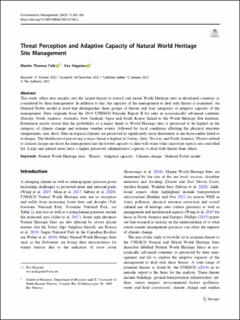| dc.contributor.author | Falk, Martin Thomas | |
| dc.contributor.author | Hagsten, Eva Marie | |
| dc.date.accessioned | 2024-04-02T12:25:04Z | |
| dc.date.available | 2024-04-02T12:25:04Z | |
| dc.date.created | 2023-01-24T11:19:08Z | |
| dc.date.issued | 2023 | |
| dc.identifier.citation | Falk, M. T., & Hagsten, E. (2023). Threat Perception and Adaptive Capacity of Natural World Heritage Site Management. Environmental Management, 71(2), 285-303. | en_US |
| dc.identifier.issn | 0364-152X | |
| dc.identifier.uri | https://hdl.handle.net/11250/3124477 | |
| dc.description.abstract | This study offers new insights into the largest threats to natural and mixed World Heritage sites in developed countries as considered by their management. In addition to this, the capacity of the management to deal with threats is examined. An Ordered Probit model is used that distinguishes three groups of threats and four categories of adaptive capacity of the management. Data originate from the 2014 UNESCO Periodic Report II for sites in economically advanced countries (Europe, North America, Australia, New Zealand, Japan and South Korea) linked to the World Heritage Site database. Estimation results reveal that the probability of a major threat to World Heritage sites is perceived to be highest in the category of climate change and extreme weather events, followed by local conditions affecting the physical structure (temperature, rain, dust). Sites in tropical climates are perceived as significantly more threatened, as are those earlier listed as in danger. The likelihood of perceiving a major threat is highest in Turkey, Italy, Norway and North America. Threats related to climate change are those the management has the lowest capacity to deal with when other important aspects are controlled for. Large and natural areas have a higher perceived administrative capacity to deal with threats than others. | en_US |
| dc.language.iso | eng | en_US |
| dc.rights | Navngivelse 4.0 Internasjonal | * |
| dc.rights.uri | http://creativecommons.org/licenses/by/4.0/deed.no | * |
| dc.title | Threat Perception and Adaptive Capacity of Natural World Heritage Site Management | en_US |
| dc.type | Peer reviewed | en_US |
| dc.type | Journal article | en_US |
| dc.description.version | publishedVersion | en_US |
| dc.rights.holder | © The Author(s) 2023. | en_US |
| dc.source.pagenumber | 285-303 | en_US |
| dc.source.volume | 71 | en_US |
| dc.source.journal | Environmental Management | en_US |
| dc.source.issue | 2 | en_US |
| dc.identifier.doi | https://doi.org/10.1007/s00267-022-01780-y | |
| dc.identifier.cristin | 2113893 | |
| cristin.ispublished | true | |
| cristin.fulltext | original | |
| cristin.qualitycode | 1 | |

